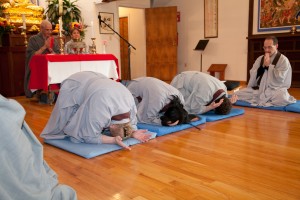Excerpted from a Dharma talk by Zen Master Wu Kwang given September 26, 2012. Boxed notes by Jess Row.
Student: I hear the word hindrance used a lot in Buddhist teaching. Could you comment?
Zen Master Wu Kwang: That’s a translation of the Sanskrit word kleśa, which has a few different nuances to it. Hindrance would be one; another might be barrier or obstacle. Sometimes it’s translated as defilement or impurity, which has a slightly religious tone to it.
|
kleśa: क्लेश (Sanskrit) Mental states that cloud the mind and manifest in unwholesome actions. |
The basic notion is we are somehow constructing things in our mind. As the Heart Sutra indicates, we are making some notion of a self, of an independent entity we call our self. As we make that fundamental construction we make many other constructions to substantiate it, to justify it. We give it legs, put a hat on it so to speak.
Those ideas, those colorations become hindrances to the simplicity of just seeing just hearing just being and just responding. We obscure clarity . . . Conventionally, those kinds of obscurations and hindrances are true. But from the ultimate standpoint they are all empty, as it says in the Heart Sutra. None of them are substantive in and of themselves.
If you can perceive that the hindrances we make — the attachments we make and are holding onto — are not what they seem to be and are not as necessary as we think they are, something opens up.
The word barrier is interesting. The Chinese character for barrier also has the connotation of a checkpoint. If you are crossing a border there is usually an immigration officer who checks your passport and papers. The point is that the checkpoint can be an opportunity to see something. You check something, you look into it, and you perceive its ultimate non-substantiality. It’s not that it doesn’t exist at all, but just that it is not substantive.
|
關 guan (Chinese) or kwon (Korean) can mean either “barrier, checkpoint, border” or “close, related to, connected with.” The three parts of the character are 門, “door,” 絲 “thread” and 丱 “loom” (i.e. threads on a loom). The kong-an collection Mumonkwon (pronounced Wumenguan in Chinese) is 無 (without) 門 (door) 關 (checkpoint), “the checkpoint that has no door,” sometimes called “the gateless gate.” |
In the morning the first thing we do is a prostration practice of 108 bows. In the Temple Rules in the section that talks about this prostration practice, it says two things: “Understand that you have made bad karma, which is like a big mountain” (so that certainly would be a hindrance, that would be an obstacle). “Keep this in mind as you bow in repentance.” This prostration practice is traditionally viewed as a practice of repentance. In Buddhism repentance has the connotation of turning back and recognizing what is essential.
|
There are many terms for “repentance” used in Zen teachings, most of which involve some notion of turning around or turning back. Two of these are 叉磨, cha mo, which literally means “to get stuck and then turn around,” and 後悔, hou hui, which literally means “afterward regret.” |
So if you perceive, “I made a mistake. I’ve done something that is not in my best interest or in others’ best interest,” then some feeling arises and perhaps the intention “I would like to let go of that” or “I would like to apologize,” some feeling of turning back to what is most important. So the first paragraph of the Temple Rules says “Understand that you have made bad karma, which is like a huge mountain, keep that in mind as you bow in repentance.” Every time you put your forehead to the floor, it’s as if you “Put it all down.” But if you too strongly hold on to the idea that this big karmic mountain is something real, that might lead to getting stuck in a feeling of guilt. Which might not be so helpful. It could become a hindrance itself.
|
Zen Master Seung Sahn’s Temple Rules are the basic instructions we follow during retreats and anytime we practice together. They are based on the traditional rules for Buddhist monastic life transmitted from India and greatly expanded by Zen teachers in China, particularly Baizhang (Pai-chang). They can be found on the Kwan Um School of Zen website (link above) and in the back of our chanting books at the Zen center. |
So the second paragraph says, “Understand that your karma comes from your mind.” Because karma means intentional action. I do something with intention, good or bad, and that in some way colors my mind energy. There is an inclination towards something. “Understand that your karma comes from your mind and originally mind is empty. When you perceive both mind and karma as essentially empty, that is termed the true repentance.” Now that has a very different feel from “You have made bad karma like a big mountain, put it down!” When you perceive that your mind and all these hindrances you’ve created in your mind are essentially empty, that is the ultimate repentance.
Then there is one more paragraph, which says, “We bow to see true nature and help others.” So that is the practice of compassion towards all beings. The purpose of our practice is to recognize our true nature and help others. And if we really perceive our true nature, we recognize that our true nature and others’ are not two separate things. At that point there is no hindrance, no checkpoint between “you” and “I”.
_________________________



